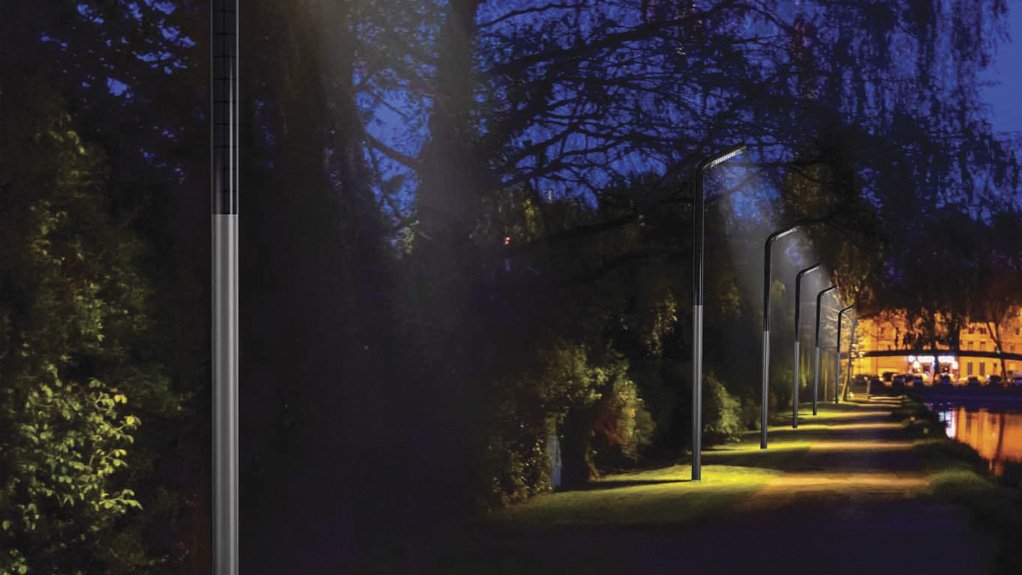To reach its goal of enlarging its footprint in Southern Africa, solar streetlight manufacturing and distribution company Solar Eco Systems Africa has made promotional magnets manufacturer Magnet Energy an exclusive distributor of its range of self-sustaining solar light-emitting diode (LED) streetlighting.
“Solar energy is gaining popularity globally as a clean, sustainable and renewable source of energy that reduces the carbon footprint. Owing to this, the self-sustaining solar LED streetlights are designed for energy conservation on streets, highways, pedestrian walkways, jogging paths and housing estates,” says Magnet Energy lighting solutions engineer Kaylen Reddy.
hat sets these lights apart from other lights in the market is their combination of enhanced aesthetics and the latest photovoltaic (PV) and LED technology, he says.
Reddy asserts that the latest LED technology of these lights has a particularly high luminous efficacy of up to 120 lumens per watt. These LEDs consume about 50% less power for every lamp than other lights available and offer about 75 000 hours of service life.
“The proprietary lens system focuses the light output and minimises unwanted stray light, which contributes to improved efficiencies.”
Further, he explains that patented PV technology encompasses high-output, high-efficiency solar cells that provide for the charging of up to 300 W a day without requiring direct sunlight. These mono-crystalline silicon cells are protected by a thick layer of borosilicate glass, which aids in keeping the PV module clean and ensures a maximum 360° energy yield.
Reddy points out that no maintenance is required until the batteries have to be changed. “The streetlights are very easy to repair. The pole comes in three parts: the LED, the PV module and the steel pole with control gear inside. This simplistic design ensures ease of repairing.”
He says this low-maintenance system can operate reliably off-grid – an important advantage during power outages.
The batteries of the lights are housed securely inside each pole, unlike traditional streetlight installations where battery boxes are buried in the ground to guard against theft. Lead acid batteries provide a minimum autonomy of two days, based on a depth of discharge of 30%.
He explains that, once the concrete base is cast and the pole bolted down, the PV module is slid down the top of the pole. Two connections are then made using plug-in connectors and a third connection at the top for the LED module. The head is then screwed on. Installation takes between 30 to 45 minutes.
Moreover, Reddy comments that a micro-controller is used for smart monitoring, intelligent communication and energy management. Each light pole communicates directly with the control centre, providing information on maintenance, with security sensors alerting on theft or tampering. It is also possible to monitor every pole’s power output to ensure optimum efficiency. As an additional option, the poles can be fitted with high-resolution closed-circuit television cameras.
“This low power consumption system has day and night sensors and offers a good image quality, even in dark areas. There is direct recording to any information technology (IT) storage device without the need for central recording software or hardware.”
Further, Reddy highlights that Solar Eco Systems Africa’s advanced technology will soon be incorporated into light poles to offer Internet connectivity.
He explains that the solar power WiFi pole – currently at its conceptual stage of research and development – will enable users in the proximity of a pole to connect to the Internet, which is “a convenient facility, especially for schools in rural communities”.
The company will also soon launch solar-powered cellphone-charging poles based on the same technology.
Additional Offerings
Reddy comments that Noor solar pedestrian light poles that provide uniform circular light distribution essential for boardwalks, pedestrian lanes, parks and communal areas are included in Solar Eco Systems Africa’s range. These standalone poles have a 6.25 m installation height and a light-spot height of 4 m.
The Shems solar streetlight poles, with lengthwise-aligned light distribution, are designed for outdoor residential and municipal lighting in areas that include streets, pavements and bicycle paths. This series has an installation height of 6.80 m and a light-spot height of 6.26 m.
The Taqa solar highway streetlight poles provide uniform lengthwise-aligned light distribution for municipal street and roadway installations. This system has an installation height of 8 m and a light-spot height of 7.65 m.
“These robust lighting poles, with a diameter of 180 mm, are manufactured from steel and are hot-dip galvanised and paint-coated for added protection. They have an IP 65 index protection rating to guard against the ingress of dust and water,” he explains.
Reddy concludes that Magnet Energy’s team is committed to identifying energy-saving opportunities and implementing appropriate ecofriendly solutions to reduce wasted electricity in South Africa.
Edited by: Zandile Mavuso
Creamer Media Senior Deputy Editor: Features
EMAIL THIS ARTICLE SAVE THIS ARTICLE
ARTICLE ENQUIRY
To subscribe email subscriptions@creamermedia.co.za or click here
To advertise email advertising@creamermedia.co.za or click here















